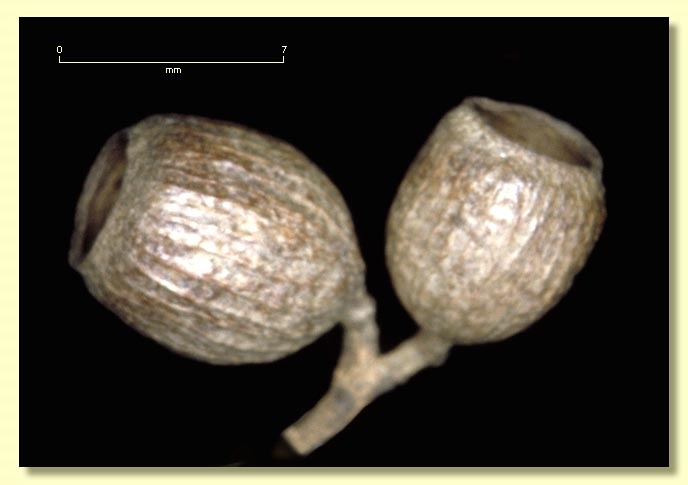Euclid - Online edition
Corymbia tessellaris
Corymbia | Blakearia
Eucalyptus tessellaris F. Muell. J. Proc. Linn. Soc., Bot. 3: 88 (1859). T: between Gilbert R. and Carron R., [Qld], 1857, F.Mueller s.n.; holo: MEL; iso: BM, K.
E. viminalis Hook. in T.L.Mitchell, J. Exped. Trop. Australia 157 (1848), nom. illeg., non Labill. (1806); E. hookeri F.Muell., J. Proc. Linn. Soc., Bot. 3: 90 (1859). T: Camp XIV, Frosty Ck near Mt Abundance, [SE of Roma, Qld,] 9 May 1846, T.L.Mitchell 146; holo: K; iso: CGE, MEL, NSW.
Bark rough on lower 1–4 m of trunk, tessellated, dark grey to black, abruptly changing to whitish smooth bark that is sometimes powdery.
Juvenile growth (coppice or field seedlings to 50 cm): stem rounded in cross-section; juvenile leaves sessile or shortly petiolate and opposite for 7–11 nodes then alternate, lanceolate, 5.5–11 cm long, 1–2 cm wide, tapering to petiole, slightly discolorous, dull, grey-green to green; stems, petioles and midribs setose for about the first 5 nodes.
Adult leaves alternate, petiole 0.5–1.5 cm long; blade narrowly lanceolate to linear, 9–24 cm long, 0.6–2.5 cm wide, base tapering to petiole, concolorous, glossy or dull, green to grey-green, strongly penniveined, densely to very densely reticulate, intramarginal vein parallel to and just within margin, oil glands island or obscure.
Inflorescence axillary compound, with an expanded rhachis with 2 to 4 internodes, peduncles 0.2–0.7 cm long, buds 3 or 7 per umbel, pedicels 0.1–0.4 cm long. Mature buds ovoid to pyriform, 0.4–0.6 cm long, 0.3–0.5 cm wide, scar present (outer operculum shed during bud development), operculum rounded and often apiculate, stamens inflexed, anthers cuboid to oblong, versatile, dorsifixed, dehiscing by longitudinal slits (non-confluent), style long, stigma tapered, locules 3, the ovules not arranged in distinct vertical rows on the placentae. Flowers white.
Fruit pedicellate (pedicels 0.1–0.3 cm long), cylindrical or urceolate, 0.6–1.2 cm long, 0.6–1 cm wide, thin-walled, disc descending, valves 3, enclosed.
Seeds brown or reddish brown, 1.5–2.2 mm long, flattened or saucer-shaped, hilum ventral.
Cultivated seedlings (measured at ca node 10): cotyledons reniform to orbicular; stems rounded in cross-section, scabrid with both multicellular bristles and simple hairs; leaves shortly petiolate, opposite for ca 7 to 10 (? or more) nodes before becoming alternate, ovate to lanceolate, 4–12 m long, 1.5–4.5 cm wide, base tapering, margin entire, apex pointed, slightly discolorous, green, paler beneath; lamina slightly scabrid with similar hairs to stems.
Flowering has been recorded in January, July, August, October, November and December.
A small to tall ghost gum tree widespread in north-eastern Australia from north and north-west of Narrabri in New South Wales, over much of eastern Queensland from Charleville to the tip of Cape York Peninsula, where it is the northernmost eucalypt on the Australian mainland. It also occurs on some islands in Torres Strait and in southern New Guinea. It prefers plains and very gently undulating terrain on a variety of soil types, and can often be found on river banks. Corymbia tessellaris is recognised by the compound axillary inflorescences with an expanded rhachis, thin-walled fruit and is notable for its distinctive stocking of tessellated bark over part of the trunk abruptly changing to smooth white above. It has a crown of fully adult lanceolate smooth (non-setose) leaves.
C. tessellaris is very similar to C. bella, a completely smooth-barked tree common from the Gulf of Carpentaria hinterland west through the Top End of the Northern Territory to Broome and Derby in Western Australia, on floodplains. Another closely related species, C. papuana, has similar infloresence arrangement to C. tessellaris but differs in having scrappy basal rough bark, not clearly tessellated, and has much broader juvenile leaves; it is restricted to northern Cape York and PNG. Within the natural range of C. tessellaris there are two other ghost gum species with a crown of fully adult leaves, viz. C. dallachiana, which differs in having smooth bark and a condensed inflorescence, and C. grandifolia subsp. grandifolia, which also has smooth bark, glossy green leaves much larger than those of C. tessellaris and a condensed inflorescence rhachis. Other ghost gum species with distributions that overlap that of C. tessellaris, are C. confertiflora and C. disjuncta, both of which have ovate-cordate crown leaves that are sparsely to densely setose, and condensed inflorescences.
MORE ABOUT CORYMBIA
MORE ABOUT GHOST GUMS













